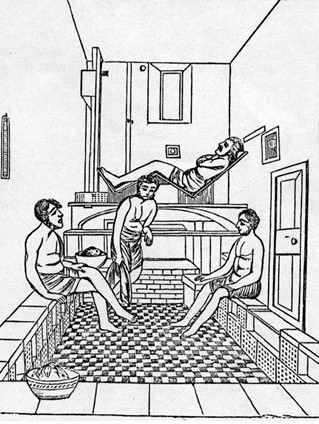George Witt's Turkish bath:
22 Princes Terrace, Ennismore Gardens,
Knightsbridge, London

Erasmus Wilson, pioneer of dermatology in Britain, described how Witt constructed his Turkish bath.
On the ground-floor of his house he had a room twenty feet long by ten feet in breadth, and twelve feet high, with a window looking out upon a lead flat. To convert this room into a thermae he divided it into two compartments, by means of a wall which crossed it at about one-third from its further end. He had thus two apartments—an outer one, the Frigidarium; and an inner one, entered by two small doors, outer and inner, in the partition wall, the Calidarium. To preserve the heat of the Calidarium a lath and plaster lining was placed inside and at the distance of a few inches from the wall, and the space between the lining and the wall filled in with sawdust. The same was done to the ceiling, and the floor was paved with earthen tiles set on concrete. On the side corresponding with the exterior of the house a square of thick glass was let into the wall, and, above and below, were four circular holes three inches in diameter, and fitted with plugs for the purpose of ventilation. Further, in the partition wall was a small square of glass through which a thermometer could be seen from the outside, and a gas-burner from the inside, enabling the bather to ascertain the temperature of the Calidarium from the outside without opening the doors, and supplying a light exterior to the Calidarium when the bath is used in the evening.1
And Sir Thomas Spenser Wells, Queen Victoria's surgeon and president of the Royal College of Surgeons of England, relates how members of the medical profession tried out the Turkish bath,
When Mr G Witt, of Knightsbridge, built a private thermae, it immediately began to excite the interest of the scientific world, and several of the leading metropolitan physicians and surgeons applied for permission to test it upon themselves. Having long known the importance of a healthy condition of the skin to the general well being of the organism, they speedily discovered and appreciated the value of the Turkish Bath as a means of regulating and exalting the cutaneous functions, and, through them, the other functions of the body, and they encouraged the erection of one or two baths in London, that they might try its effects upon persons afflicted with disease.2
With such leading medical practitioners advocating the Turkish bath, it is, perhaps, surprising how many lesser medics were adamant that the new therapy was just another form of quackery.
This page first published 21 November 2023
This page enlarges an image or adds to the information found below:
Victorian Turkish baths for animals in Victorian London and Middlesex

Victorian Turkish Baths: their origin, development, and gradual decline



Comments and queries are most welcome and can be sent to:
malcolm@victorianturkishbath.org
The right of Malcolm Shifrin to be identified as the author of this work
has been asserted by him
in accordance with the Copyright, Designs and Patents Act 1988
© Malcolm Shifrin, 1991-2023